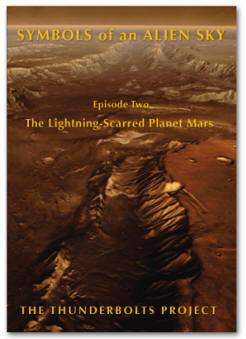It Has a Nice Ring To It
Jul
25, 2011
Galactic haloes are best explained using
the Electric Universe theory.
There are rings around planets, rings around
stars, and there are rings around galactic
nuclei, as demonstrated by the Hubble Space
Telescope image of AM 0644-741. Although the
conventional explanation for such structures is
that they are formed when one or more collisions
between galaxies take place, electricity flowing
through plasma is a more likely cause.
It is possible that stellar haloes are
examples of a
dense plasma focus penumbra, with AM
0644-741 being a dramatic example. Images taken
of plasma gun experiments provide a direct
analogue to its galaxy-scale discharge.
A
dense plasma focus device is usually
constructed from two electrodes made of copper
or beryllium cylinders, one inside the other.
They are confined within a vacuum chamber, with
low pressure gas between the cylinders. An
electric pulse is sent across the electrodes,
causing an intense electric current to flow from
the outer electrode to the inner electrode for a
few milliseconds. The electric arc heats the gas
between the cylinders, creating a plasma and an
intense magnetic field. The magnetic field
"pinches" the plasma into tiny filaments called
a charge sheath.
The filament sheath flashes to the end of the
inner electrode where the plasma compresses into
a magnetically confined "plasmoid." The magnetic
field decays, inducing an electric field that
accelerates an electron beam in one direction
and a beam of positive ions in the other. The
electron beam heats the plasmoid to energies of
100,000 electron volts, the equivalent to
billions of Kelvin in temperature.
AM 0644-741 is most likely equivalent to the
rings that surround
SN1987a, except on a galactic scale.
As the electric current pinches down, variations
in plasma density cause individual filaments in
the gun's current sheath to glow. Double layers
accelerate the charge carriers that then emit
extreme ultraviolet light and X-rays.
A double layer consists of an electric charge
separation that forms in current-carrying
plasma. Two oppositely charged parallel layers
generate an electric field across the layer,
accelerating charged particles in opposite
directions, which produces an electric current.
If the voltage drops and the separation between
layers is great enough, electrons can reach
velocities approaching the speed of light.
Double layers in plasma can self-generate
between two regions of different properties.
The
dense plasma focus device
provides a precise mechanism by which cosmic
electric currents can influence the evolution
and morphology of space structures (See Peratt,
A. L. and Dessler, A. J. “Filamentation of
Volcanic Plumes on the Jovian Satellite Io.”
Astrophysics and Space Science volume
144, numbers 1-2, May 1988, pages 451-461).
Just as the helical strands from the core of
galaxy NGC 3079 are an indication
that electricity is discharging from its
nucleus, the swirling toroids that constrain the
hot stars in the halo of AM 0644-741 conform to
the Electric Universe theory.
A signature phenomenon in a dense plasma
focus is helical strands of energy surrounding a
powerful arc-mode discharge and a dark-current
torus. The helical strands are plasma confined
by magnetic fields into something like "power
lines" in space, otherwise known as Birkeland
current filaments. That phenomenon is present in
the plasma gun discharge that makes up AM
0644-741.
Stephen Smith
 New
DVD
New
DVD
The Lightning-Scarred
Planet Mars
A video documentary that could
change everything you thought you
knew about ancient times and
symbols. In this second episode of
Symbols of an Alien Sky, David
Talbott takes the viewer on an
odyssey across the surface of Mars.
Exploring feature after feature of
the planet, he finds that only
electric arcs could produce the
observed patterns. The high
resolution images reveal massive
channels and gouges, great mounds,
and crater chains, none finding an
explanation in traditional geology,
but all matching the scars from
electric discharge experiments in
the laboratory. (Approximately 85
minutes)
Video Selections
Order Link





 New
DVD
New
DVD

